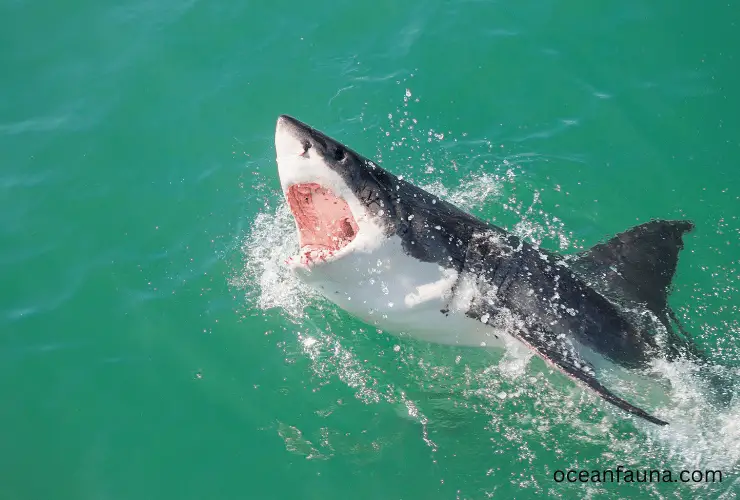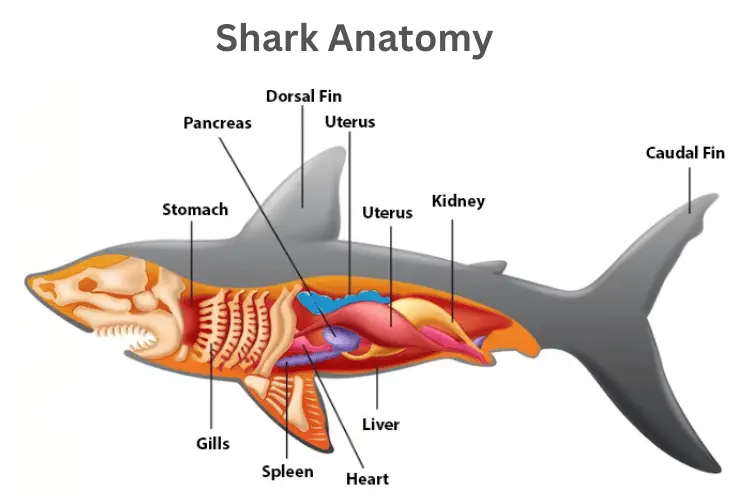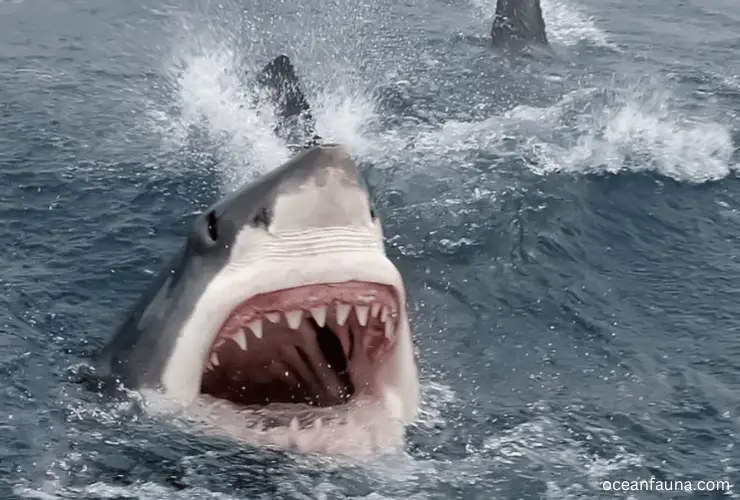As you know, sharks are the ultimate predator of the ocean. So, they eat almost everything. When they took their prey inside their mouth, they used their sharp teeth to break down the flesh and bones.
Now, the question is, do sharks eat bones?
Well, yes. Sharks can eat bone and also digest them. In this article, we will know about this fact in detail.
Do Sharks Eat Bones?
Sharks are well-known for having some of the strongest teeth in the animal kingdom and can easily bite through bones. Sharks have even been observed to swallow larger vertebrates such as sea turtles whole. This means that they can easily consume the bones of these animals, including their shells and skeletal system.
Sharks have evolved to digest these bones, along with any other matter they may consume. Bones are a nutrient-rich resource that offers a variety of essential minerals and vitamins that sharks need to maintain healthy growth and development.
Sharks also consume small fish and invertebrates, which require them to crunch through skulls and spines to access their nutritious organs, muscles, and fatty tissues inside. Sharks will use their razor-sharp teeth and powerful jaws to crunch through bones like these to access the nutritional content within them.
Sharks crush and eat bones for food and use them as a tool for defense when dealing with potentially dangerous situations or prey items. By using their strong jaws and pointed teeth, sharks can break apart bony structures, if necessary, which is why sharks are more powerful than human bites!

Although not all species of shark eat bones directly (some prefer softer foods), many species do feed on bone-filled prey items such as sea turtles, rays, or cetaceans like whales or dolphins when given the opportunity.
By feasting on the bones of their prey, sharks not only get access to essential nutrients and vitamins but also have a chance to scavenge for what remains in large animal carcasses found at sea. This serves as an advantageous boost in nutrition levels for them.
Such occasions could provide additional sources of advantageous nutrition should it become necessary for survival.
Can Sharks Eat Human Bones?
Although sharks never take humans as regular prey or food. But if human remains get mixed with other sea animal carcasses, then sharks do feed on them. So yes, sharks can eat human bones, but only if they find something like that in their natural environment.
In 2013, a group of scientists studying the behaviour of tiger sharks off the coast of Hawaii discovered that out of 64 tiger shark stomachs they examined, some contained human remains. They found evidence of four separate individuals whose bones had been consumed by these animals.
Additionally, an analysis of bite marks on the bones indicates that these sharks likely ate these humans while they were still alive.
In August 2018, a group of scientists from Stanford University published their research on the feeding habits of great whites in the journal Marine Ecology Progress Series.
They concluded that great white sharks appear to be actively seeking out and consuming human remains when presented with them as prey items. This behaviour was observed most commonly in areas close to active fisheries or sites where human bodies are frequently discarded at sea.
Can Sharks Bite Through Bone?
Whether or not sharks can bite through bone depends on the type of shark in question and the characteristics of the bone itself.
Many species of shark have teeth that are well-suited for piercing and tearing through tough materials, including bone. The ability to do so is often attributed to the structure of a shark’s teeth, which are usually serrated and extremely sharp.
However, the hardness and thickness of the bones will ultimately determine if a given species of shark can chomp through them.
For instance, Great White Sharks have been observed biting through whale bones with ease due to their very strong jaw muscles and large serrated teeth.

On the other hand, smaller species, such as Leopard Sharks, may not be capable of enough pressure to break through thick bones.
In some cases, it has even been found that sharks incapable of penetrating hard or thick bones will end up going around them instead. This is seen in Tiger Sharks, who have been known to find alternative routes through tough material by navigating alongside rather than directly into a dense object such as a bone.
When considering a specific scenario, it becomes important to consider how strong any given species’ jaws may be relative to how thick the bone might be that they’re attempting to bite into.
For example, if a Bull Shark were trying to bite into an animal carcass with large leg bones too thick for its serrated teeth to penetrate, then it would simply be unable to do so – regardless of its jaws possessing immense strength compared to its size.
How Powerful Sharks’ Bite Are?
The bite force of sharks is one of the most remarkable and well-studied natural phenomena in the animal kingdom. Sharks have incredibly powerful jaws that enable them to tear through some of their prey, such as sea turtles and large fish. Additionally, their bite forces are capable of crushing even hard bones.
The white shark (Carcharodon carcharias) is considered one of the strongest biting sharks, with an estimated bite force of between 1-2 tons per square inch. This means that a single tooth from a white shark can exert up to 4,000 pounds of pressure per square inch (PSI).
The tiger shark (Galeocerdo cuvier) and the bull shark (Carcharhinus leucas) also possess impressive jaw strength with estimated bite forces between 1250-2500 PSI. Meanwhile, smaller sharks like the lemon shark (Negaprion brevirostris) typically have weaker bites with an estimated force between 250-625 PSI.
Other species of sharks, such as the great hammerhead (Sphyrna mokarran), are known for their immense jaw power as well, with an estimated force between 375-750 PSI; this makes it possible for them to crush hard-shelled prey like crabs and mollusks with ease.
Furthermore, the great white has been observed to feed on large whales due to its tremendous bite force since it can pierce through thick layers of skin and blubber.
Sharks’ jaws are made up of several rows totaling hundreds or thousands of teeth arranged in a wave pattern, so when they close their mouths, multiple teeth engage with one another, providing further leverage and thus increasing their ability to apply more pressure onto their prey.
Scientists believe this unique arrangement allows these powerful predators to crush harder materials and helps them keep a firm grip on slippery prey during capture, making them formidable hunters.
In addition to jaw strength, sharks’ teeth are surprisingly tough and sharp due to their very high levels of calcium phosphate mineral called apatite, which makes them capable of piercing through hard items like bone or chitin shells many other animals cannot eat easily.
Interestingly enough, some species, like whitetip reef sharks, actually use their specialized teeth structures called ‘labial ferments’ to suck out chunks of flesh from their prey, the same way humans use straws for drinking beverages.
All these remarkable adaptations combined make these ancient beasts incredibly effective hunters allowing them to survive millions of years despite the harsh conditions and ever-changing environment they inhabit in today’s world.
How Do Sharks Digest Bones?
Sharks have a unique way of digesting bones. In most animals, bones are composed of calcium phosphate and other minerals that the body can’t use. Sharks, however, possess strong acids that allow them to break down and dissolve these hard substances.
The stomach acid in sharks is extremely powerful, even more so than that found in humans or any other animal. It has a pH level of 1-2, which makes it almost as acidic as battery acid! This low pH allows them to break down materials such as bone that would otherwise be impossible to digest.
Once the bones are dissolved, they are then absorbed by the small intestine and converted into useful nutrients for the shark’s body.

But that’s not all – some species of sharks also have specialized organs called gastroliths which help grind up larger pieces of food like fish bones or shell fragments before they enter the stomach. These gastroliths are tiny stones that act like teeth to chew harder material before digestion begins, making it easier for sharks to process their meals.
Nevertheless, not all species of sharks have the capability to dissolve bones. The small opening size from the stomach to the intestine limits large objects and indigestible items from passing through. However, these can be expelled through its mouth by regurgitation.
Overall, it’s amazing how well-adapted sharks are to survive and thrive in their environment despite the unusual diet they have evolved with over time. Their ability to digest even tough materials like bone demonstrates that evolution has equipped them with incredible skills necessary for survival – skills we can all learn from and appreciate!
Do Sharks Eat Bony Fish?
Sharks such as reef and thresher sharks, which are mid-sized in size, primarily sustenance on bony fish like sardines, anchovies, and herring. This is due to the abundance of these small specimens – they form schools that become a convenient food source for the shark.
Additionally, these small fish are relatively easy to catch as they lack an effective defense mechanism against predators. They are usually found in shallow waters near coastlines or in open oceans, providing a plentiful food supply for mid-sized sharks.
Smaller species of bony fish, like minnows and smelt, can also be consumed by other species of sharks, like tiger and hammerhead, who often hunt within deeper oceanic depths where larger prey is not available.
Bony fishes are an important part of a shark’s diet; without them, some species would not have sufficient nutrients necessary for survival.
Conclusion
Sharks are remarkable predators equipped with specialized parts such as teeth and powerful stomach acid that allows them to hunt and digest a wide variety of prey, including their bones.
Their unique capabilities show us how evolution has shaped these ancient creatures to survive in their ever-changing environment.


1 thought on “Do Sharks Eat Bones? [Yes, Here’s How]”